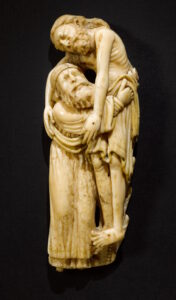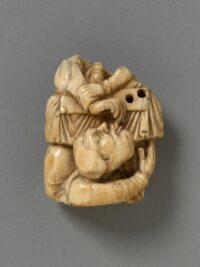 The UK’s Arts Minister has placed a temporary export bar on a rare 12th century walrus ivory carving of the Deposition from the Cross to give local institutions the opportunity to raise the £2,006,595 (plus VAT of £40,131.90) necessary to acquire it for the nation. It was bought by the Metropolitan Museum of Art in a private sale arranged by Sotheby’s. A domestic buyer will have to either secure the full cost or show that they have a strong chance of reaching the goal by February 2nd. The deadline can then be extended until June if a serious effort to raise the funds is made. The likeliest UK buyer is the V&A which had the Deposition on long-term loan for four decades before the sale. The museum has not commented on whether it will make an attempt to acquire it.
The UK’s Arts Minister has placed a temporary export bar on a rare 12th century walrus ivory carving of the Deposition from the Cross to give local institutions the opportunity to raise the £2,006,595 (plus VAT of £40,131.90) necessary to acquire it for the nation. It was bought by the Metropolitan Museum of Art in a private sale arranged by Sotheby’s. A domestic buyer will have to either secure the full cost or show that they have a strong chance of reaching the goal by February 2nd. The deadline can then be extended until June if a serious effort to raise the funds is made. The likeliest UK buyer is the V&A which had the Deposition on long-term loan for four decades before the sale. The museum has not commented on whether it will make an attempt to acquire it.
The Romanesque ivory carving depicts Joseph of Arimathea taking the body of Christ down from the cross. The quality of the detail work is exceptionally high.
[Reviewing Committee on the Export of Works of Art and Objects of Cultural Interest]
Member Tim Pestell said:This mediaeval ivory depiction of the Deposition of Christ is a truly remarkable object, both for its early date and its sublimely skilful carving. Delicately observed and showing dignified restraint in its depiction of the dead Christ, it represents one of the finest surviving examples of English Romanesque ivory carving. This rarity means we have much to learn from it, ranging from examining its artistic design and the workshop that produced it, to scientific investigation of the walrus ivory it is made of that might tell us about mediaeval exploitation of the environment, and trade and exchange networks.
There was a brisk trade in walrus ivory in the Middle Ages. Its flesh-like luster, ease of carving and durability made it highly prized as luxury ornamentation, especially of religious objects, and it was readily available from Viking walrus hunters in Scandinavia and Greenland when elephant ivory was scarce. Inspired by Early Medieval Byzantine ivories, northern European carvers created plaques, low relief inlays, book covers, bishops’ croziers followed by increasingly elaborate and three-dimensional tabernacles and altarpieces.
 The Deposition is believed to have been part of a much larger altarpiece with scenes from the Passion of the Christ. Today the only fragments from the ensemble believed to survive are the section depicting the Deposition of Christ and a smaller fragment of Judas eating the wine-imbued bread that Jesus passes him at the Last Supper marking him as the betrayer.
The Deposition is believed to have been part of a much larger altarpiece with scenes from the Passion of the Christ. Today the only fragments from the ensemble believed to survive are the section depicting the Deposition of Christ and a smaller fragment of Judas eating the wine-imbued bread that Jesus passes him at the Last Supper marking him as the betrayer.
The Judas fragment, which is about half the size of the Deposition and only shows Judas’ head in profile, the hand of Christ and draped garments, was donated to the V&A in 1949. It was because of the Judas fragment that Gertrude Hunt, owner of the Deposition, loaned it to the V&A in 1982. The two were on display together in the museum’s medieval gallery until the owner reclaimed it in 2022 in order to sell it.
“Join the cultural rollercoaster as the UK’s Arts Minister hits the brakes on a 12th-century walrus ivory marvel – a stunning Deposition from the Cross – giving local institutions a chance to rescue it from foreign hands. With a heart-stopping price tag of £2,006,595 (plus a dash of VAT drama), the race is on, and the V&A might just be the hometown hero. Uncover the intricacies of this Romanesque masterpiece, explore the tantalizing history of walrus ivory in the Middle Ages, and discover why this carving has the art world holding its breath. Will the UK keep its medieval gem, or will it bid adieu to a piece that’s more than just ivory and history?”